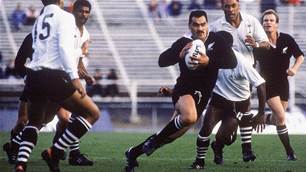A Western Sydney course known for its vast array of bunkers is far more multi-faceted than the sea of sand first suggests.
A WESTERN SYDNEY COURSE KNOWN FOR ITS VAST ARRAY OF BUNKERS IS FAR MORE MULTI-FACETED THAN THE SEA OF SAND FIRST SUGGESTS.
The first thing newcomers to Twin Creeks invariably notice is the sand. From the opening tee shot to the final approach, bunkers fill not only your vision but also your mind – and your navigational instincts need to be primarily based on avoiding the ‘camel grass’ in most instances.
However, after a few excursions around Graham Marsh’s seven-year-old layout in Sydney’s west, you realise that while there are plenty of sprawling bunkers, many of them are unlikely to trouble every golfer. Short hitters won’t reach many of the traps from the tee while bombers will airmail all the ‘sighter’ bunkers. Likewise, faders and hookers will rarely miss greens on their ‘off’ side, effectively eliminating a whole bunch more.
Still, it is sand that characterises the Twin Creeks design. Its 80-plus orange-hued bunkers support the semi-rural look of the overall property and form the backbone of most strategic decisions during 18 holes. The 545-metre par-5 9th hole best illustrates this notion. Bunkers either side of the landing area provide a prelude to the rest of the journey to the cup as no fewer than 11 traps litter the edges of the fairway and encircle the green. From the tee it can be an imposing view yet in truth there is plenty of space to work with, especially if your plan is to reach the green in three or four blows and therefore avoid most of the bunkers.
Later, at the driveable par-4 12th, the decision from the tee becomes one of attempting to knock it on the green and challenge the long bunker fronting the putting surface that also extends rearward into the fairway or to play a safe iron shot well to the left of the pit and pitch safely on from there. While bunkers might prove a less-daunting hazard when it comes to weighing up the repercussions of a misfire, a long bunker shot is never near the top of a golfer’s favourite shots to attempt.
And the myriad bunkers are currently receiving a gradual freshen-up. The club recently began a program of reconstructing all the bunkers, which cover about two-and-a-half hectares of the property. The purpose of the work is to sharpen the faces of the traps and improve their drainage and the intention is for two or three bunkers to be completed each month. However only keen eyes will notice the difference as the focus of the project is on reconstruction rather than redesign.
Yet it’s not all about the sand. Some of Twin Creeks’ best holes use elevation changes, interesting green complexes and water to great effect, most notably as the course builds to a grandstand finish. The quest for the clubhouse begins in earnest from the par-3 14th, which has a devilishly difficult green to hold from 179 metres and is at times equally tough to putt on depending on where your ball finishes in relation to the cup. It’s one of those uphill one-shotters that can occasionally punish a good shot more than a well-positioned missed green if your ball finishes in the wrong part of the undulating green. Next, the fairway of the 525-metre par-5 15th climbs a rise from the tee then meanders around a fairway bunker before reaching a green angled to aid a left-to-right approach. Miss left and your ball will bounce towards the trees lining the entire left side of the hole; miss right and it’s in the sand.
The 16th is a beefy 417-metre par-4 with open spaces from the tee but water guarding the right side of a green that sits highest on that side. It’s a putting surface in three portions – the front and left segments can take the water out of play but the raised right part is not only difficult to hit and hold from a distance, it places the water squarely in the golfer’s view. The downhill, 163-metre 17th is a picturesque par-3 that features a small pond short and left but the most demanding hazard here is the green itself, as a huge spine running through the centre of the surface splits the green in two and forces you to find the correct half or face an ominous two-putt up and over the ridge.
The best at Twin Creeks is saved for last. The 402-metre 18th begins in a grove of trees that forms a chute for your drive and points towards a large fairway bunker that is sure to consume any decent drive not turned from right-to-left with the shape of the dogleg. From there it’s a lengthy approach over water that flanks the front-left corner of a green guarded by sand right and long, providing no bail-out for the approach.
Earlier, a trio of holes on the front nine stimulates the golfing senses. The 302-metre 3rd is a driveable par-4 for big hitters who feel compelled to cut the corner but is a straightforward lay-up and pitch for the rest of us – just watch the hidden fallaway at the rear of the green. The next is a 395-metre par-4 where driver can be too much from the tee on occasion if the wind is following or the fairways are running, as a narrow creek cuts across the fairway. Whichever club you take from the tee, it must be hit straight to avoid a lateral hazard down the right side and a copse of gum trees on the left. From there a three-lobed green makes striking a pinpoint iron shot important. The long par-3 6th can be played from one of two tees set at entirely different angles. The back tee stretches to 186 metres and asks golfers to play between two stands of trees that don’t come into play from the alternate tee positioned further to the right (from where the hole measures 160 metres). The shot from either tee needs to find a broad green that rarely feeds balls nearer to the hole, especially in the wickedly small pocket on the extreme left side of the putting surface.
There’s little to be critical of anywhere on the Twin Creeks course. Power lines and towering pylons plus a water pipeline come into view on the early holes of the back nine but are aesthetic intrusions only and do nothing to hurt the overall layout. Design-wise, several holes appear to lack the flair of others yet are genuine ‘sleepers’. The 5th hole, which features a creek dividing the fairway about 90 metres short of the green on the 513-metre par-5, usually plays as a prescribed three-shooter with minimal opportunity to reach the green in two. But even then the lay-up is no picnic. A subtle upslope in the fairway gets your attention as any second shot that’s too timid risks hitting it and pulling up 150 or more metres away when finding the ideal lay-up shelf might shorten the third shot by another 30 to 40 metres. The par-4 7th looks like the ultimate sleeper hole until the cup is cut in the rear portion of what is a sliver of a green in comparison to some of the more spacious putting surfaces. And the 356-metre 13th can lull golfers into a false sense of security with its wide fairway and seemingly generous green, but the shortest grass is split by a small hump that propels balls towards the back fringe and makes it tough to finish near flags in the rear half.
Twin Creeks exhibits the best and favourite elements of Marsh’s vast array of design tools. He utilises the site’s best natural assets to fine effect in designing a layout that flows seamlessly and builds to an exciting – and exacting – crescendo. The collection of opening holes is very good, but during any round here always lurking at the back of your mind is the need to play your best golf in the final five holes.
THE COURSE
LOCATION: Luddenham Rd, Luddenham. Take the M4 motorway west from the Sydney CBD and turn left at the Mamre Rd exit, turning right into Luddenham Rd a few minutes later. Alternatively, take the M5 and M7 then Elizabeth Drive, which links to Luddenham Rd. Twin Creeks is about a 50-minute drive from the city.
CONTACT: (02) 9670 8888.
WEBSITE: www.twincreeks.com.au
DESIGNER: Graham Marsh (2006).
PLAYING SURFACES: Bent Providence (greens), Legends couch (fairways), Santa Ana couch (tees).
PGA PRO: Nathan Snell and Asef Haddad.
GREEN FEES: $85, including cart and a burger (but only for a limited period).
THE CLUB
MEMBERSHIPS: Memberships at Twin Creeks remain open, with full membership requiring a $4,000 joining fee and $2,945 in annual fees. A new category of membership will open shortly that covers weekday golf (Monday to Friday) for a $2,000 joining fee and $1,500 annually. Junior membership costs $500 and intermediate $1,200 (for 18 to 23-year-olds).
CORPORATE AND GROUP DAYS: Corporate golf days at Twin Creeks are assigned a personal group co-ordinator who organises all aspects of your day including bag drop, pre-event registration,
a players briefing, on-course competition and
banner services, collection of scorecards, scoring,
post-golf presentation set up and all food and beverage requirements.
ACCOMMODATION: The club has accommodation arrangements with the Novotel at Rooty Hill and the Chifley Hotel at Penrith, which are 16 and 18 kilometres away, respectively.
PACKAGES: Twin Creeks allows limited non-member play at certain times for $85, which includes golf, cart use and a ‘Swampy’ burger in the clubhouse, named after the popular nickname for the course’s designer.
Related Articles

International Spotlight: Omanu Golf Club

Celebrity Kiwi couple tee off in paradise













